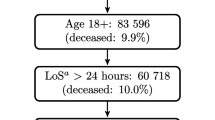Abstract
Health care effectiveness and efficiency are under constant scrutiny especially when treatment is quite costly as in Intensive Care (IC). At the heart of quality of care programs lie prognostic models whose predictions for a particular patient population may be used as a norm to which actual outcomes of that population can be compared. This paper motivates and suggests a method based on Machine Learning and Statistical ideas to study the behavior of current IC prognostic models for predicting in-hospital mortality. An application of this method to an exemplary logistic regression model developed on the IC data from the National Intensive Care Evaluation registry reveals the model’s weaknesses and suggests ways for developing improved prognostic models.
Preview
Unable to display preview. Download preview PDF.
Similar content being viewed by others
References
Abu-Hanna A, Lucas PJF. Prognostic Models in Medicine AI and Statistical Approaches, (Abu-Hanna A. and Lucas PJF, eds.). Special issue of Methods of Information in Medicine 2001, 40:1–5.
Bennett D, Bion J. ABC of Intensive Care. Organisation of Intensive Care. BMJ 1999; 318:1468–1470.
Cleveland, W. S. (1979) Robust Locally Weighted Regression and Smoothing Scatterplots. J. Amer. Statist. Assoc. 74, 829–836.
Hand DJ. Construction and Assessment of Classification Rules. Chichester: John Wiley and Sons, 1997.
Hosmer D.W., Lemeshow S. Applied Logistic Regression, Wiley, New-York, 1989.
Hosmer D.W., Hosmer T., Le Cessie S., Lemeshow S. A Comparison of Goodness-of-fit Tests for the Logistic Regression Model. Statistics in Medicine 1997; 16:965–980.
de Keizer N. An Infrastructure for Quality Assessment in Intensive Care; Prognostic Models and Terminological Systems. PhD Thesis, 2000, University of Amsterdam.
Knaus W, Draper E, Wagner D, Zimmerman J. APACHE II: a Severity of Disease Classification System. Crit Care Med 1985; 13:818–829.
Kohavi R. Scaling Up the Accuracy of Naive-Bayes Classifiers: a Decision-Tree Hybrid. Proc. of the Second Int. Conference on Knowledge Discovery and Data Mining. 1996; 202–207.
Le Gall J, Lemeshow S, Saulnier F. A New Simplified Acute Physiology Score (SAPS-II) Based on a European/North American Multicenter Study. JAMA 1993; 270:2957–2963.
Long WJ. A Comparison of Logistic Regression to Decision-Tree Induction in a Medical Domain. Compt Bio Res 1993:74–97.
Lucas PJF, Abu-Hanna A. Prognostic Methods in Medicine (Lucas PJF and Abu-Hanna A. eds.). Special issue of Artificial Intelligence in Medicine. 1999; 15(2):105–119.
Miller M.E., Hui S.L. Validation Techniques for Logistic Regression Models. Statistics in Medicine, 1991, Vol 10, pp. 1213–1226.
Rowan K, Kerr J, Major E, McPherson K, Short A, Vessey M. Intensive Care Society’s APACHE II study in Britain and Ireland-II. BMJ 1993; 307:977–981.
Schwarzer G, Vach W, Schumacher M. On Misuses of Artificial Neural Networks for Prognostic and Diagnostic Classification in Oncology. Statistics in Medicine 2000; 19: 541–561.
Author information
Authors and Affiliations
Editor information
Editors and Affiliations
Rights and permissions
Copyright information
© 2001 Springer-Verlag Berlin Heidelberg
About this paper
Cite this paper
Abu-Hanna, A., de Keizer, N. (2001). A Classification-Tree Hybrid Method for Studying Prognostic Models in Intensive Care. In: Quaglini, S., Barahona, P., Andreassen, S. (eds) Artificial Intelligence in Medicine. AIME 2001. Lecture Notes in Computer Science(), vol 2101. Springer, Berlin, Heidelberg. https://doi.org/10.1007/3-540-48229-6_13
Download citation
DOI: https://doi.org/10.1007/3-540-48229-6_13
Published:
Publisher Name: Springer, Berlin, Heidelberg
Print ISBN: 978-3-540-42294-5
Online ISBN: 978-3-540-48229-1
eBook Packages: Springer Book Archive




